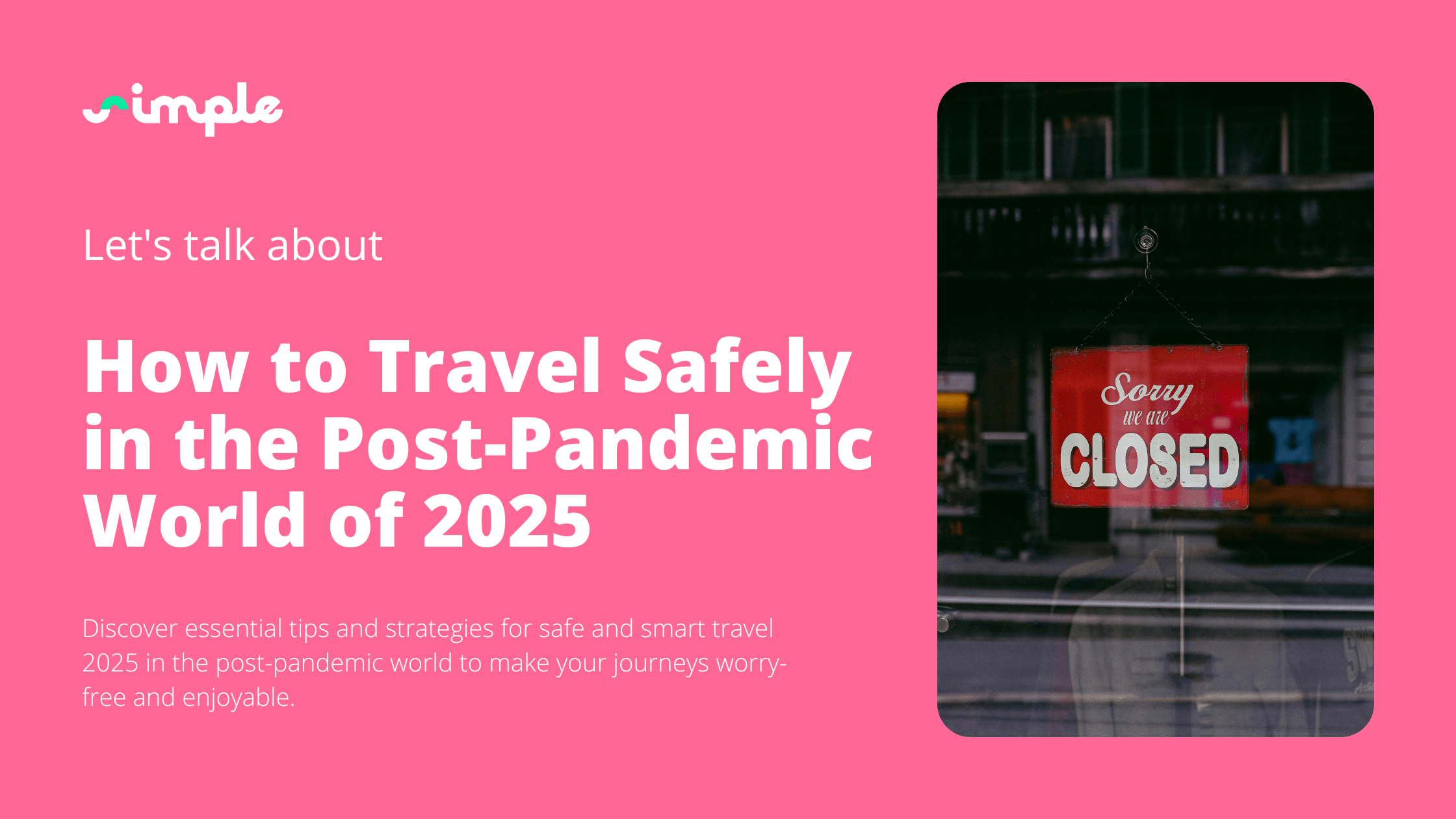How to Travel Safely in the Post-Pandemic World of 2025

As the world steadily moves toward 2025, the travel landscape is undergoing significant transformation. The global pandemic has reshaped how people approach travel, emphasizing health, safety, and adaptability more than ever before. Travelers today are not only seeking new destinations but are also prioritizing safety measures and sustainable practices to ensure their journeys are both enjoyable and secure. This shift reflects a broader awareness of the importance of responsible travel in a world that continues to navigate the challenges of public health and environmental concerns.
In this evolving environment, understanding the latest travel safety guidelines and adopting new standards has become essential. The post-pandemic world demands more than just traditional travel planning; it requires a proactive approach to health protocols, technology integration, and flexible itineraries. From enhanced sanitation procedures to contactless services and real-time health monitoring, the travel industry is innovating rapidly to meet these new expectations. Travelers who stay informed and prepared can confidently explore emerging travel hotspots while minimizing risks.
Growing traveler awareness is driving a shift toward more conscious and informed travel decisions. The emphasis on sustainable travel 2025 and eco-friendly travel options reflects a commitment to preserving destinations for future generations while protecting personal well-being. Additionally, advancements in travel technology advancements are making it easier to access up-to-date information, book safer accommodations, and navigate travel restrictions with ease. This new era of travel combines convenience with caution, allowing for adventure without compromising safety.
For those looking to stay ahead in this dynamic travel environment, resources focused on travel 2025 provide valuable insights and practical tips. Whether planning a luxury travel trend experience or an adventure travel 2025 trip, understanding the evolving safety landscape is crucial. By embracing these new standards and leveraging innovative tools, travelers can enjoy peace of mind and make the most of their journeys in the post-pandemic world.

Understanding Health and Safety Protocols in 2025
Updated global health regulations and requirements
As travel continues to evolve in 2025, global health regulations have become more standardized yet adaptable to regional needs, reflecting lessons learned from the pandemic. Vaccination and testing mandates remain a cornerstone of international travel safety. Many countries now require proof of full vaccination or a recent negative COVID-19 test before entry, with some destinations expanding these requirements to include booster shots or specific vaccine types. These mandates are designed to reduce the risk of virus transmission and protect both travelers and local populations.
Digital health passports and verification tools have become essential components of the travel process. These technologies allow travelers to securely store and share their vaccination status, test results, and other health information with airlines, border control, and accommodation providers. The integration of these digital tools streamlines the verification process, reduces physical contact, and minimizes delays at checkpoints. Many travel technology advancements in 2025 focus on enhancing the security and interoperability of these health passports, ensuring they are accepted across multiple countries and platforms.
Quarantine and isolation policies have also been refined to balance safety with traveler convenience. While some destinations maintain strict quarantine requirements for unvaccinated or symptomatic travelers, others have adopted more flexible approaches, such as shortened quarantine periods combined with testing or symptom monitoring. These policies are frequently updated based on real-time epidemiological data, allowing for rapid response to emerging variants or outbreaks. Travelers are encouraged to stay informed about the specific requirements of their destinations and to plan accordingly to avoid disruptions.
Airline and airport safety enhancements
Airlines and airports have implemented a range of safety enhancements to protect passengers and staff. Contactless check-ins and boarding processes have become standard practice, reducing physical interactions and streamlining passenger flow. Mobile apps and biometric identification systems enable travelers to check in, drop off luggage, and board flights with minimal contact, improving efficiency and safety.
Improved air filtration systems are now a critical feature of modern aircraft. High-efficiency particulate air (HEPA) filters, which capture airborne particles including viruses, are widely used to maintain clean cabin air throughout flights. Airlines have also increased the frequency of cabin sanitization, focusing on high-touch surfaces such as tray tables, armrests, and lavatories. These measures contribute to a safer in-flight environment and help restore traveler confidence.
Passenger spacing and crowd control measures have been introduced to reduce congestion in airports and on planes. Many airlines limit the number of passengers per flight or adjust seating arrangements to increase physical distancing. Airports have redesigned waiting areas, security lines, and boarding gates to minimize crowding and facilitate social distancing. These changes, combined with mandatory mask policies in many regions, create a safer travel experience from check-in to arrival.
Accommodation and local transportation precautions
Hotels and other accommodations have adopted rigorous hygiene standards and certification programs to reassure guests. Many properties participate in internationally recognized cleanliness certification schemes that verify adherence to enhanced sanitation protocols. These programs often include regular deep cleaning, use of hospital-grade disinfectants, and staff training on health and safety practices. Contactless check-in and digital room keys are increasingly common, reducing physical contact between guests and staff.
Public transportation systems have also stepped up cleanliness protocols. Buses, trains, and ride-sharing services now follow strict sanitization schedules, focusing on high-touch areas such as handrails, seats, and payment terminals. Many cities have introduced ventilation improvements and capacity limits to reduce the risk of virus transmission. Travelers using local transportation are encouraged to wear masks and practice hand hygiene, especially in crowded or enclosed spaces.
Flexible cancellation and booking policies have become a key feature of travel planning in 2025. Recognizing the uncertainty that can still arise from changing health regulations or personal circumstances, many hotels and transportation providers offer refundable or reschedulable options. This flexibility provides peace of mind, allowing travelers to adjust plans without significant financial penalties. Travel planning 2025 increasingly emphasizes adaptability, ensuring that safety and convenience go hand in hand.

Practical Tips for Travelers to Stay Safe
Preparation before departure
Thorough preparation is the foundation of safe travel in 2025, especially in a post-pandemic world where health considerations remain paramount. One of the most important steps before departure is researching destination-specific health advisories. Each country or region may have unique requirements regarding vaccinations, testing, quarantine, or mask mandates. Staying updated on these regulations through official government websites or trusted travel resources ensures compliance and helps avoid unexpected disruptions. Additionally, understanding the local healthcare infrastructure and emergency contact information can be invaluable in case of illness or other health concerns during the trip.
Packing essentials has evolved beyond the traditional checklist to include health and safety items that are now indispensable. Masks, hand sanitizers, disinfectant wipes, and personal health kits containing items like thermometers and over-the-counter medications are critical for managing hygiene and minor health issues on the go. Many travelers also carry reusable masks and portable UV sanitizers to maintain cleanliness in various environments. These items support adherence to travel safety guidelines and provide peace of mind when navigating airports, public transport, and crowded tourist spots.
Understanding travel insurance options that cover health emergencies is another crucial aspect of travel planning 2025. Not all insurance policies offer comprehensive coverage for COVID-19-related incidents or other pandemic-related complications. Travelers should seek plans that include medical treatment, quarantine accommodations, trip cancellations, and emergency evacuation. This coverage protects against unforeseen expenses and ensures access to quality care if health issues arise abroad. Comparing policies and reading the fine print carefully can prevent costly surprises and contribute to a worry-free journey.
Behavior during travel
Maintaining good hygiene and social distancing during transit remains a key strategy for minimizing health risks. Frequent hand washing or sanitizing, avoiding touching the face, and wearing masks in crowded or enclosed spaces are simple yet effective measures. Travelers should be mindful of high-touch surfaces such as handrails, elevator buttons, and seating areas, using disinfectant wipes when possible. Adhering to these practices aligns with travel safety guidelines and helps reduce the likelihood of infection during flights, train rides, or bus journeys.
Avoiding high-risk areas and crowded venues is an important consideration when exploring travel destinations 2025. Popular tourist attractions, busy markets, and nightlife hotspots can present increased exposure to viruses, especially in regions with fluctuating infection rates. Opting for outdoor activities, visiting emerging travel hotspots with lower visitor density, or scheduling visits during off-peak hours can significantly reduce risk. This approach also supports sustainable travel 2025 by encouraging responsible tourism that respects local communities and environments.
Leveraging travel technology advancements can further minimize physical contact and streamline the travel experience. Mobile apps for contactless payments, digital boarding passes, and real-time health updates enable travelers to navigate airports, accommodations, and local transport with reduced interaction. Many destinations now offer QR code-based menus, virtual tours, and online check-ins, all designed to limit touchpoints. Embracing these innovations not only enhances safety but also aligns with future travel trends focused on convenience and health-consciousness.
Post-travel considerations
Monitoring health for any symptoms after returning from a trip is essential to protect both the traveler and their community. Symptoms such as fever, cough, or fatigue should prompt immediate self-isolation and consultation with a healthcare provider. Early detection and responsible behavior help prevent potential spread, especially in the context of emerging variants or localized outbreaks. Keeping a symptom diary and noting any unusual health changes can assist medical professionals in diagnosis and treatment.
Following local health guidelines for self-isolation or testing after travel remains a critical step in post-travel safety. Many countries and regions recommend or require quarantine periods depending on the traveler’s vaccination status and exposure risk. Adhering to these protocols demonstrates social responsibility and helps maintain public health. Travelers should stay informed about evolving recommendations and be prepared to adjust plans accordingly, including remote work travel arrangements if necessary.
Keeping digital records of travel history, including flight details, accommodation, and places visited, supports efficient contact tracing if exposure to illness occurs. Many health authorities and travel apps facilitate this process by allowing users to log their movements securely. Maintaining these records can expedite communication with health officials and reduce the impact of potential outbreaks. This practice complements broader travel industry forecasts that emphasize data-driven approaches to managing health risks and ensuring traveler safety in 2025 and beyond.

Leveraging Technology and Support Services
Role of mobile apps and platforms in travel safety
In 2025, travel technology advancements play a pivotal role in enhancing traveler safety and convenience. Mobile apps and digital platforms have become indispensable tools for navigating the complexities of post-pandemic travel. One of their most valuable features is providing real-time updates on travel restrictions and health alerts. These apps aggregate information from government agencies, health organizations, and local authorities, delivering timely notifications about changes in entry requirements, quarantine rules, or outbreak hotspots. This instant access to accurate data empowers travelers to make informed decisions and adjust their plans proactively, reducing the risk of unexpected complications.
Access to telemedicine and virtual health consultations through mobile platforms has also transformed how travelers manage their health on the road. Instead of seeking in-person medical care, which can be challenging or risky in unfamiliar locations, travelers can connect with healthcare professionals remotely. These services offer diagnosis, prescription, and advice for a range of health issues, including COVID-19 symptoms and other common ailments. Telemedicine not only enhances safety but also supports sustainable travel 2025 by minimizing unnecessary hospital visits and reducing strain on local healthcare systems.
Navigation tools integrated into travel apps help users identify safe routes and venues, further supporting health-conscious travel. These tools often include features such as crowd density maps, contactless payment options, and reviews focused on hygiene standards. By guiding travelers to less crowded or certified eco-friendly travel options, these technologies align with future travel trends that prioritize both safety and sustainability. The convenience and reliability of these digital aids make them essential companions for anyone exploring emerging travel hotspots or engaging in adventure travel 2025.
Importance of government and international cooperation
Government and international cooperation remain critical to maintaining safe and efficient travel in the post-pandemic era. Streamlining visa and entry processes with integrated health compliance measures has become a priority for many countries. Collaborative efforts have led to the development of standardized digital health passports and interoperable verification systems, simplifying border crossings while ensuring rigorous health checks. This harmonization reduces confusion and delays, facilitating smoother travel experiences and supporting the broader travel industry forecasts for growth and recovery.
Coordinated responses to emerging health threats are essential to prevent localized outbreaks from escalating into global crises. Governments and international organizations now share data and resources more effectively, enabling rapid identification and containment of new variants or infectious diseases. This cooperation extends to joint research initiatives, vaccine distribution, and public health campaigns, all of which contribute to a safer travel environment. Travelers benefit from these efforts through more consistent travel safety guidelines and reduced risk of sudden restrictions or closures.
Support networks for travelers during emergencies have also expanded through international collaboration. Many countries have established dedicated hotlines, online portals, and consular services to assist travelers facing health issues, travel disruptions, or other emergencies abroad. These resources provide critical information, facilitate medical evacuations, and offer logistical support, ensuring that travelers are not left isolated in challenging situations. The availability of such support enhances confidence in travel planning 2025 and encourages responsible tourism.
How travel agencies and services are adapting
Travel agencies and service providers have adapted swiftly to the new realities of post-pandemic travel by offering flexible, customized travel plans tailored to individual needs and safety concerns. Recognizing the importance of adaptability, many agencies now provide options for last-minute changes, cancellations, and rescheduling without hefty penalties. This flexibility is particularly valuable given the unpredictable nature of travel restrictions and health advisories. Customized itineraries also allow travelers to focus on emerging travel hotspots or eco-friendly travel options that align with their preferences and safety priorities.
Transparency about safety measures has become a key selling point for travel agencies. Providers are increasingly upfront about the hygiene protocols, certification programs, and health compliance standards of their partners, including airlines, hotels, and local tour operators. This openness helps build trust and reassures travelers that their well-being is a top priority. Agencies often incorporate detailed information about travel safety guidelines into their communications, empowering clients to make informed choices and feel secure throughout their journeys.
Offering resources and guidance tailored to new traveler needs is another way agencies are evolving. Many now provide comprehensive support that includes up-to-date information on travel insurance options, health requirements, and technology tools for safe travel. Some agencies specialize in niche markets such as remote work travel or adventure travel 2025, catering to specific interests while maintaining a strong focus on safety and sustainability. These services reflect broader future travel trends that emphasize personalization, convenience, and responsible tourism, ensuring that travelers can navigate the complexities of the post-pandemic world with confidence.

Embracing Safe and Enjoyable Travel in 2025
As the travel industry continues to recover and evolve, there is a strong sense of cautious optimism for safe and enjoyable travel in 2025. The lessons learned from recent global health challenges have led to significant improvements in travel safety guidelines, technology, and infrastructure. These advancements create an environment where travelers can explore new destinations with greater confidence and peace of mind. The integration of health protocols, flexible planning options, and innovative tools means that travel no longer requires compromising safety for adventure or comfort. Instead, these elements work together to support a more resilient and responsible travel experience that meets the demands of today’s world.
Future travel trends indicate a growing emphasis on sustainability and health-conscious choices, reflecting a shift in traveler priorities. Sustainable travel 2025 and eco-friendly travel options are becoming mainstream, encouraging visitors to minimize their environmental impact while supporting local communities. Emerging travel hotspots offer fresh opportunities for exploration away from overcrowded areas, aligning with both safety and sustainability goals. Whether engaging in adventure travel 2025 or enjoying luxury travel trends, travelers can expect a more thoughtful and secure approach to their journeys. This balance between excitement and caution is key to making the most of travel in the post-pandemic era.
Staying informed and proactive is essential to navigating the evolving travel landscape confidently. The rapid pace of change in health regulations, travel technology advancements, and destination-specific requirements means that up-to-date knowledge is a traveler’s best asset. Utilizing reliable sources, mobile apps, and support services can help individuals anticipate challenges and adapt plans as needed. Being prepared with the right information and resources not only enhances safety but also reduces stress and uncertainty. This proactive mindset empowers travelers to embrace new experiences while maintaining control over their health and well-being.
Ultimately, the future of travel in 2025 is shaped by a collective commitment to safety, flexibility, and responsibility. By adopting post-pandemic travel tips and adhering to travel safety guidelines, individuals contribute to a safer global travel environment for everyone. The combination of technology, cooperation, and informed decision-making creates a foundation for memorable and secure journeys. As the world opens up to new possibilities, travelers who approach their adventures with awareness and care will find that the rewards of exploration remain as rich and fulfilling as ever.